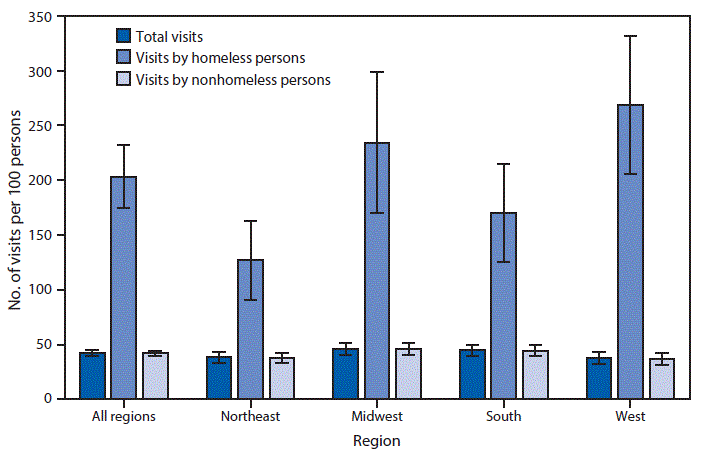QuickStats: Rate of Emergency Department (ED) Visits,* by Homeless Status† and Geographic Region§ — National Hospital Ambulatory Medical Care Survey, United States, 2015–2018¶
Weekly / December 18, 2020 / 69(50);1931

* Visit rates for the homeless population are based on sets of estimates of the U.S. homeless population, reported by the U.S. Department of Housing and Urban Development, from data collected on a single night in January of each year during 2015–2018. Visit rates for the total population are based on sets of estimates of the U.S. civilian, noninstitutionalized population developed by the U.S. Census Bureau’s Population Division and reflect the population as of July 1 of each year during 2015–2018. The nonhomeless population was computed by subtraction. Error bars indicate 95% confidence intervals.
† Homeless persons are identified as being homeless or living in a homeless shelter. Nonhomeless persons are identified as having a private residence, living in a nursing home, or having some other living arrangement. Patient residence was missing for 2.3% of ED visits; these records were excluded from the analysis.
§ Northeast: Connecticut, Maine, Massachusetts, New Hampshire, New Jersey, New York, Pennsylvania, Rhode Island, and Vermont. Midwest: Illinois, Indiana, Iowa, Kansas, Michigan, Minnesota, Missouri, Nebraska, North Dakota, Ohio, South Dakota, and Wisconsin. South: Alabama, Arkansas, Delaware, District of Columbia, Florida, Georgia, Kentucky, Louisiana, Maryland, Mississippi, North Carolina, Oklahoma, South Carolina, Tennessee, Texas, Virginia, and West Virginia. West: Alaska, Arizona, California, Colorado, Hawaii, Idaho, Montana, Nevada, New Mexico, Oregon, Utah, Washington, and Wyoming.
¶ Based on a sample of visits to EDs in noninstitutional general and short-stay hospitals, exclusive of federal, military, and Veterans Administration hospitals, located in U.S. states and the District of Columbia.
During 2015–2018, there were annual averages of 42 ED visits per 100 total population, 42 ED visits per 100 nonhomeless persons, and 203 ED visits per 100 homeless persons. Within each region, the rate of ED visits among homeless persons was higher than the rate for nonhomeless persons. The rates of visits for nonhomeless persons did not differ by region; however, among homeless persons, visit rates were higher in the West (268) than in the Northeast (127) and South (170) and higher in the Midwest (234) than in the Northeast.
Source: National Center for Health Statistics, National Hospital Ambulatory Medical Care Survey, 2015–2018. https://www.cdc.gov/nchs/ahcd/ahcd_questionnaires.htm.
Reported by: Susan M. Schappert, MA, sds0@cdc.gov, 301-458-4480; Loredana Santo, MD; Jill J. Ashman, PhD.
Suggested citation for this article: QuickStats: Rate of Emergency Department (ED) Visits, by Homeless Status and Geographic Region — National Hospital Ambulatory Medical Care Survey, United States, 2015–2018. MMWR Morb Mortal Wkly Rep 2020;69:1931. DOI: http://dx.doi.org/10.15585/mmwr.mm6950a8external icon.
MMWR and Morbidity and Mortality Weekly Report are service marks of the U.S. Department of Health and Human Services.
Use of trade names and commercial sources is for identification only and does not imply endorsement by the U.S. Department of
Health and Human Services.
References to non-CDC sites on the Internet are
provided as a service to MMWR readers and do not constitute or imply
endorsement of these organizations or their programs by CDC or the U.S.
Department of Health and Human Services. CDC is not responsible for the content
of pages found at these sites. URL addresses listed in MMWR were current as of
the date of publication.
All HTML versions of MMWR articles are generated from final proofs through an automated process. This conversion might result in character translation or format errors in the HTML version. Users are referred to the electronic PDF version (https://www.cdc.gov/mmwr) and/or the original MMWR paper copy for printable versions of official text, figures, and tables.
Questions or messages regarding errors in formatting should be addressed to mmwrq@cdc.gov.